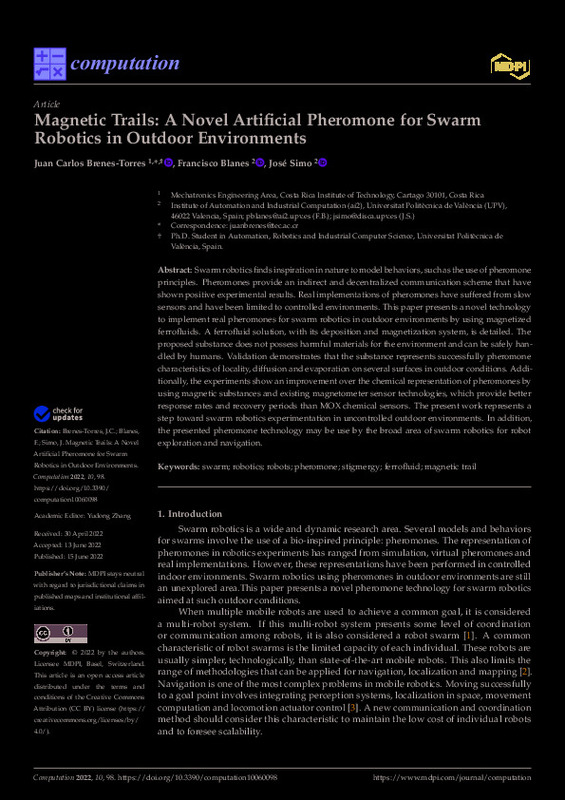JavaScript is disabled for your browser. Some features of this site may not work without it.
Buscar en RiuNet
Listar
Mi cuenta
Estadísticas
Ayuda RiuNet
Admin. UPV
Magnetic Trails: A Novel Artificial Pheromone for Swarm Robotics in Outdoor Environments
Mostrar el registro sencillo del ítem
Ficheros en el ítem
| dc.contributor.author | Brenes-Torres, Juan Carlos
|
es_ES |
| dc.contributor.author | Blanes Noguera, Francisco
|
es_ES |
| dc.contributor.author | Simó Ten, José Enrique
|
es_ES |
| dc.date.accessioned | 2024-01-15T19:00:44Z | |
| dc.date.available | 2024-01-15T19:00:44Z | |
| dc.date.issued | 2022-06 | es_ES |
| dc.identifier.uri | http://hdl.handle.net/10251/201927 | |
| dc.description.abstract | [EN] Swarm robotics finds inspiration in nature to model behaviors, such as the use of pheromone principles. Pheromones provide an indirect and decentralized communication scheme that have shown positive experimental results. Real implementations of pheromones have suffered from slow sensors and have been limited to controlled environments. This paper presents a novel technology to implement real pheromones for swarm robotics in outdoor environments by using magnetized ferrofluids. A ferrofluid solution, with its deposition and magnetization system, is detailed. The proposed substance does not possess harmful materials for the environment and can be safely handled by humans. Validation demonstrates that the substance represents successfully pheromone characteristics of locality, diffusion and evaporation on several surfaces in outdoor conditions. Additionally, the experiments show an improvement over the chemical representation of pheromones by using magnetic substances and existing magnetometer sensor technologies, which provide better response rates and recovery periods than MOX chemical sensors. The present work represents a step toward swarm robotics experimentation in uncontrolled outdoor environments. In addition, the presented pheromone technology may be use by the broad area of swarm robotics for robot exploration and navigation. | es_ES |
| dc.description.sponsorship | We would like to warmly thank Cindy Calderon-Arce. This paper was achieved thanks to her support and advice. Special thanks also to Research and Outreach Vice-Rectory at Costa Rica Institute of Technology (VIE, ITCR), for their support of PROE project (code VIE 1440036). | es_ES |
| dc.language | Inglés | es_ES |
| dc.publisher | MDPI AG | es_ES |
| dc.relation.ispartof | Computation | es_ES |
| dc.rights | Reconocimiento (by) | es_ES |
| dc.subject | Swarm | es_ES |
| dc.subject | Robotics | es_ES |
| dc.subject | Robots | es_ES |
| dc.subject | Pheromone | es_ES |
| dc.subject | Stigmergy | es_ES |
| dc.subject | Ferrofluid | es_ES |
| dc.subject | Magnetic trail | es_ES |
| dc.subject.classification | ARQUITECTURA Y TECNOLOGIA DE COMPUTADORES | es_ES |
| dc.title | Magnetic Trails: A Novel Artificial Pheromone for Swarm Robotics in Outdoor Environments | es_ES |
| dc.type | Artículo | es_ES |
| dc.identifier.doi | 10.3390/computation10060098 | es_ES |
| dc.relation.projectID | info:eu-repo/grantAgreement/ITCR//VIE 1440036/ | es_ES |
| dc.rights.accessRights | Abierto | es_ES |
| dc.contributor.affiliation | Universitat Politècnica de València. Escola Tècnica Superior d'Enginyeria Informàtica | es_ES |
| dc.description.bibliographicCitation | Brenes-Torres, JC.; Blanes Noguera, F.; Simó Ten, JE. (2022). Magnetic Trails: A Novel Artificial Pheromone for Swarm Robotics in Outdoor Environments. Computation. 10(6):1-16. https://doi.org/10.3390/computation10060098 | es_ES |
| dc.description.accrualMethod | S | es_ES |
| dc.relation.publisherversion | https://doi.org/10.3390/computation10060098 | es_ES |
| dc.description.upvformatpinicio | 1 | es_ES |
| dc.description.upvformatpfin | 16 | es_ES |
| dc.type.version | info:eu-repo/semantics/publishedVersion | es_ES |
| dc.description.volume | 10 | es_ES |
| dc.description.issue | 6 | es_ES |
| dc.identifier.eissn | 2079-3197 | es_ES |
| dc.relation.pasarela | S\471248 | es_ES |
| dc.contributor.funder | Instituto Tecnológico de Costa Rica | es_ES |








